
After only a couple of minutes of riding the trail away from your truck, the fresh fields of new powder beckon to you. This is it: the moment you’ve been waiting for. Virgin snow lies ahead, sparkling in the morning light. You ARE the Ski-Doo commercial, living the dream. Off the trail with about half a handful of throttle, the machine sings across the top of the freshly fallen snow. Life is good. The machine dips and pushes the snow away like a streamlined ski-boat as you crest the rolling drifts; it is exhilarating. This is why you bought this sled, no doubt about it, it is worth every penny. A smile broadens across your face.
The end of the field quickly looms: time to turn around. The smile fades as you grit your teeth with determination, lean to the inside of the corner and turn the skis in that direction. The machine pitches to the outside and digs in throwing cold mist over your face and obscuring your vision. You lean inside even harder and pull the machine briefly level with all your might, only to have it roll away from you again. As this wallowing routine repeats itself, you no longer resemble the Dance of the Snow Queen From the Nutcracker Ballet, the action more closely looks like the time you tried to help your 250 pound drunken roommate up four flights of stairs at 3AM.
Invariably the battle ends as you land on your back, looking up at the blue sky. The only thing bruised is your ego. The machine is on its side, all 570 wet pounds of it, stuck. You wrestle yourself onto your belly; in a manner you’d rather not have video taped, to survey your pathetic situation.
Next thing you know a beat machine, wailing pipes and a ripped seat held together with duct tape alone, comes screaming towards you. The rider is not seated but is moving back and forth while the machine plays a tune over the terrain. You are certain the guy can write script across the field with the way he is tossing that thing around. How can he do that? Maybe he is writing, “Time to rescue the newbie!” He completes his dance with a final, steeply banked 360-degree turn in an area about the size of your bathtub, coming to a stop about 10 feet away. Snow all over his machine and an ear-to-ear grin appearing under his helmet: “Need some help, dude?”….
Sound familiar? The riding techniques necessary to turn a mountain machine in the powder are not rocket science, but they are not natural either. We all have learned some very bad habits from driving cars that do not translate well to powder riding. Why is powder riding so difficult and trail riding so easy? Why, when I climb a little hill at even the slightest hint of angle, do I end up making one side of the McDonalds arch instead of going up and over?
When a snowmobile is on a hard trail, it drives like a car. We can all relate to the handling characteristics of a small car in the snow. It brakes, accelerates, turns right and left… no sweat. Powder riding is different because the machine is not firmly supported and this makes it handle more like a canoe and less like a car.
What are the ways we can turn a canoe? One way is to shift our weight to one side. With some forward momentum and a little weight shift, the canoe will slowly turn in a gentle arc. Another way is to paddle on only one side or, more applicable in our case, we can drag one paddle dramatically turning the canoe. Both the shifting of weight and the dragging of a paddle can be applied to powder riding.
Let’s revisit the machine as it glides at half throttle effortlessly in a straight line across a powder field. With the power ON, the machine is being pushed by the track so that the front end of the machine is lifted out of the snow, and rides on top. This is like a boat that has been thrust “on the step”. In this configuration the majority of the weight of the machine is on the track and not the front end. When the power is shut off, all the weight dives to the front and you can kiss powder riding good bye as the snow runs over the hood and into your face.
Rule #1 of powder riding: the power must be ON
The track is very narrow compared to the front end of the machine (like a canoe is narrow) and thus it is very susceptible to slight shifts in weight. A little weight shift to the left (everything else remaining constant, such as the power staying ON, and the skis staying STRAIGHT) and the machine will turn gently to the left.
I want to further define what I mean by weight shift. What it is NOT is a seated rider that leans in the direction of the turn. Think about this, if you want to rock a canoe to one side, sit squarely in the middle and lean over for a mild effect, or, GET UP and put your feet on the outside rails and roll it dramatically with minor shifts of body weight.
Rule #2 of powder riding: GET UP OFF YOUR BUTT.
Powder machines have tall handlebars (check out the Summit REV, Yamaha Mountain Viper, Polaris RMK, Cat Mountain Cats) so that you can negotiate the machine with weight shift from a comfortable standing position. To increase the effectiveness of weight shift, follow along with the series of photos below.
In this first photo, the rider is standing straight on the machine. He can simply shift weight from one foot to another and provide some lateral roll.

This second photo shows the rider with both feet on the same side of the machine but the outboard knee is resting on the seat. As the rider’s body weight shifts more to one side, so it does increase the roll of the machine.

The third photo shows both the rider’s feet firmly planted on the inside running board, increasing the roll of the machine by merely using his body weight and NOT by using excessive muscle strength.
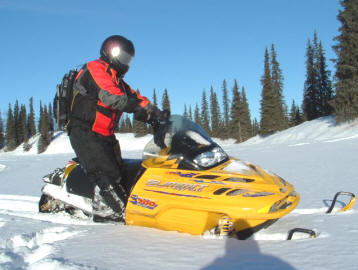
The fourth photo adds to the last as the rider now plants both feet on the inside running board, leans inboard and pulls the sled over. This dramatically increases the rolling action and is used for the more radical turning maneuvers.
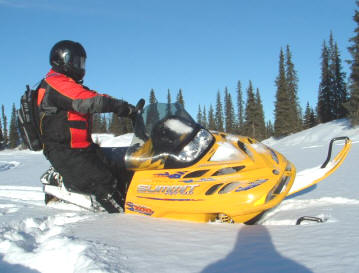
Rule #3 of powder riding: MOVE YOUR FEET and shift your weight.
Remember when I discussed turning the canoe and said it could be done by dragging a paddle on one side? You can do that on a snowmobile too and this is probably the single hardest thing a seasoned car driver can learn but it is really one of the most effective turning methods. The technique I am referring to is called “counter-steering” and here is how it works.
First I need to cover some fundamentals. Skis are turned by the spindle, located in the middle of the ski. That means that if the handle bars turn to the left, the front half of the ski, (the tips), turns to the left, BUT the rear of the ski, that portion behind the spindle, actually moves to the RIGHT of the machine. The next photo illustrates. Notice that it is the TAIL of the ski that concerns us here.
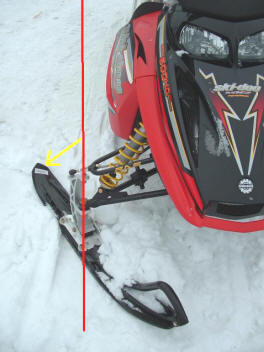
When rule #1 is being followed and the power is ON, the weight of the machine is transferred to the track and it is digging a trench pushing the rest up so the sled is at a positive angle in relation to the terrain. This means, and follow closely here, that the front half of the skis have little to no weight on them as they are mostly OUT of the snow while the tails are buried deep (see the next picture to illustrate).
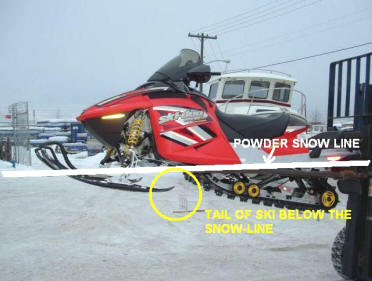
When the ski is turned (again under power) to the left, the front half of the ski moves to the left and has very little effect because the tub of the machine is being forced up and out, BUT, at the same time the rear of the ski is shoved deep and pushes to the RIGHT side acting exactly like a paddle being drug and therefore it wants to drag the whole rig to the right instead of the left. So, if you want that “paddle” dragging action to work FOR you in the desired turning direction, you MUST turn OPPOSITE the direction of the turn, counter-steer, putting the tail of the ski on the same side you want to turn to.
Rule #4 of powder riding: Turn opposite the direction of the turn, counter-steer.
I know there are some spinning heads here. Yes, this is counter-intuitive and you must FORCE yourself to try it. Think about that first scenario that was painted at the beginning of this article. When the guy in that story turned in the direction of the turn, he effectively drug his “paddle” (the rear portion of the ski) on the opposite side of the desired direction of the turn canceling his leaning-turning efforts and he ended up wallowing nowhere.
Here are a couple pictures of this technique. Look at the moving picture and see the rider’s body position and the direction of the skis.
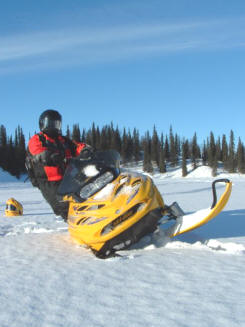

In summary, there are four pieces to this puzzle: One is to keep the power ON. The more power, the more effective all your efforts will be, and the more aggressive your turns will be. Two is to get your butt off the seat. Staying seated is a zero aggression stance and powder riding takes some aggression. Three is to shift your weight. Move your feet and make gravity work for you by getting both feet on one rail. The more you move your feet, the less you have to work pulling and the more the machine will respond. Finally, counter-steer. Counter-steering when combined with the other three will turn that sled on a dime. Play with varying levels of all these things and see how different degrees affect your turns. Snow conditions also come into play as does the depth of the snow. If the snow is not deep enough, then all bets are off and the machine may behave like a trail sled.
The same skills mentioned here apply to side-hilling also. Learn them on the flat lands and then slowly apply them to small hills. The next thing you know, you will be side-hilling with one ski out in the air like the guys in those radical snowmobile videos (minus the obnoxious music)!
Enjoy and ride safe!

~ John S. Harris, P.E.
![[Kar's sled page]](images/winter_home3.gif)